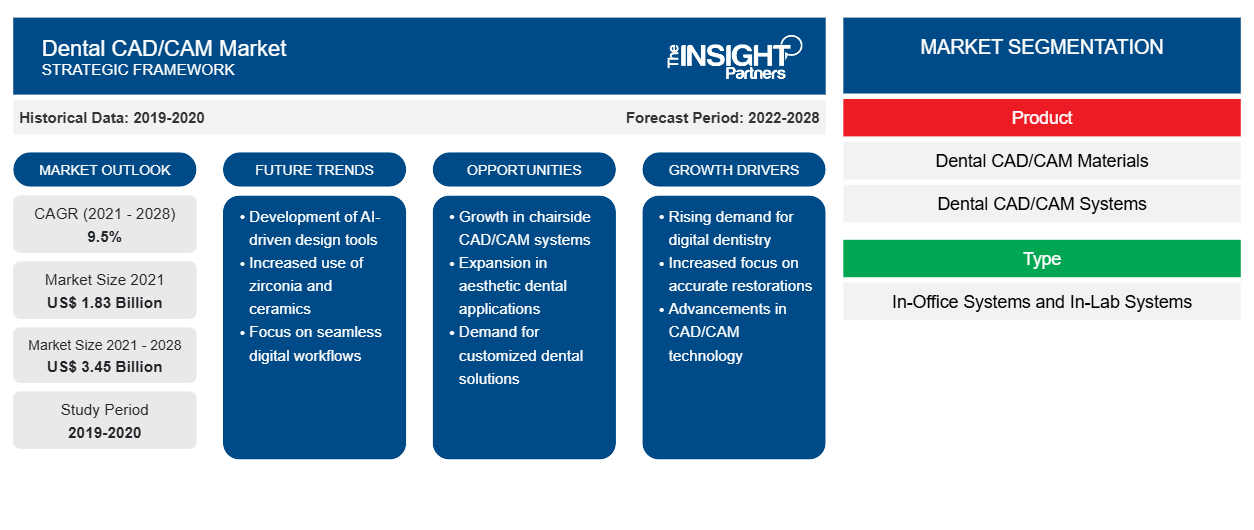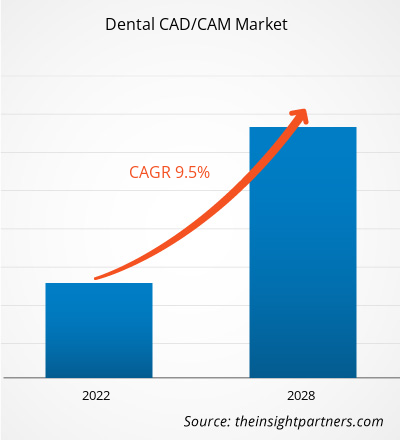The dental CAD/CAM market is expected to grow from US$ 1,829.77 million in 2021 to US$ 3,447.12 million by 2028; it is estimated to grow at a CAGR of 9.5% from 2021 to 2028.
Dental Computer-Aided Design and Computer-Aided Manufacturing or CAD-CAM is the automation technology that helps in tooth restoration. CAD/CAM complements previous technologies used for these dental solutions by increasing the speed of design and manufacture and increasing the suitability and simplicity of the invention, construction, and placement processes. This technology has enabled restorations that would otherwise not have been feasible. Other goals are to reduce unit costs and make tooth repairs affordable. The rise in the incidence of tooth loss, growth in the edentulous population, advantages of dental CAD/CAM-based restorations over dental laboratory restorations, technological advances in dental CAD/CAM systems, growth in dental service organizations, and increasing demand for advanced dental solutions are expected to drive the dental CAD/CAM market growth.
Customize This Report To Suit Your Requirement
You will get customization on any report - free of charge - including parts of this report, or country-level analysis, Excel Data pack, as well as avail great offers and discounts for start-ups & universities
Dental CAD/CAM Market: Strategic Insights

-
Get Top Key Market Trends of this report.This FREE sample will include data analysis, ranging from market trends to estimates and forecasts.
The dental CAD/CAM market is segmented on the basis of product, type, components, application, end user, and geography. By geography, the dental CAD/CAM market is broadly segmented into North America, Europe, Asia Pacific, the Middle East & Africa, and South & Central America. The report offers insights and in-depth analysis of the dental CAD/CAM market, emphasizing parameters such as market trends, technological advancements, market dynamics, and the analysis of the competitive landscape of the world’s leading market players.
Market Insights
Increasing Oral Diseases and Geriatric Population Drives the Dental CAD/CAM Market Growth
The increasing number of dental diseases is one of the main factors contributing to the dental industry growth. According to the National Center for Health Statistics (US), in April 2021, ~13.2% of children (5–19 years) and ~25.9% of adults (20–44 years) had untreated dental caries in North America. Additionally, the National Center for Health Statistics reported that 64.9% of US adults aged 19 and above; and 85.9% of children aged 2–17 years visited the dentist at least once in 2019; in March 2020, ~3.5 billion people suffered from dental conditions, such as untreated tooth decay (dental caries). In addition, the WHO found that oral cancer is among the top three most commonly detected cancers in Asia-Pacific countries. According to the United Nations World Aging Population, ~703 million people globally aged 65 or above in 2019, and the number is expected to double to 1.5 billion in 2050. Oral health is directly linked to aging due to biological, behavioral, and socioeconomic factors, thus leading to deterioration in oral health among the geriatric population. As the geriatric population increases globally, the demand for dental procedures will grow and fuel the dental CAD/CAM market growth.
Rising Adoption of Chair-Side CAD/CAM Systems Contributes Significantly to Market Growth
In dentistry, computer-aided design and manufacturing (CAD/CAM) technologies have expanded rapidly. The product preparation is scanned with the chairside technique, and the restoration is then fabricated in the milling device (CEREC 3, Sirona, E4D, D4D TECH). Chairside CAD/CAM systems have been trending in the market for several years due to the proven effectiveness and accuracy of restoration design using these systems. Dentists consider dental chair CAD/CAM systems to save time, increase patient visits, and improve income. These systems allow dentists to control the entire process, starting with the digital impression of prepared teeth to design and fabrication of the dental restorations. These systems offer unique advantages, such as better patient comfort, shorter procedure times, and improved quality. They also provide dentists a competitive edge by helping them deliver digital services faster. Therefore, many dentists are adopting chair-side CAD/CAM systems, thus driving the dental CAD/CAM market growth.
Product launches, and mergers and acquisitions are the highly adopted strategies by the players operating in the global dental CAD/CAM market. A few of the recent key product developments are listed below:
- In May 2021, CIMsystem announced the launching of a new product MillBox. This new product possesses an interface developed explicitly for immediate use, with exciting new features, allowing dentists to work faster.
- In December 2021, Envista Holdings Corporation announced the US Food and Drug Administration (FDA) clearance for the Nobel Biocare N1 implant system. The new product approval boasts a biologically driven design of components and forward-thinking treatment protocols, representing a significant step toward patient-centric implant solutions.
- In June 2020, Zimmer Biomet and Zfx (offer quality CAD/CAM restorative components for the industry's most popular dental implant connection) announced the launch of GenTek, a new restorative digital product line for the Zimmer Biomet dental implant system. The newly launched product brings restorative solutions based on patient's needs by strengthening the integrity of clinically proven implant connection design.
The COVID-19 pandemic substantially impacted dental diagnostics in several regions due to the closure of practices. The COVID-19 pandemic radically changed clinical and surgical routines, profoundly affecting many healthcare and surgical practices, such as limited workforce, prioritization of procedures, and intraoperative transmission. According to the Agency for Healthcare Research and Quality report, the onset of the COVID-19 pandemic in 2019 forced ~198,000 active dentists and dental specialists to close their practices in the US. Additionally, the COVID-19 pandemic witnessed delayed dental care among patients owing to stringent closure of dental offices, reluctance to seek care during the pandemic, loss of employer-sponsored dental insurance coverage, and other factors. Pre-pandemic dental CAD/CAM technology was gaining high traction as routine dental visits offer lucrative opportunities by providing preventive oral healthcare and detecting oral manifestations of systemic disease that have been enormously missed during the COVID-19 pandemic.
The COVID-19 pandemic has also impacted the dental 3D printing market. However, 3D printer sales are increasing rapidly after the initial slowdown. In addition, digital technologies, such as 3D printers and intraoral scanners, offer better contamination risk control, and this has already started to increase sales. As improvements in technology provide reliability, the demand for digital technology in dentistry will likely be higher. Additionally, digital technologies offer better security and infection control, which is expected to drive their adoption in the future.
Dental CAD/CAM Market Regional InsightsThe regional trends and factors influencing the Dental CAD/CAM Market throughout the forecast period have been thoroughly explained by the analysts at The Insight Partners. This section also discusses Dental CAD/CAM Market segments and geography across North America, Europe, Asia Pacific, Middle East and Africa, and South and Central America.
Dental CAD/CAM Market Report Scope
| Report Attribute | Details |
|---|---|
| Market size in 2021 | US$ 1.83 Billion |
| Market Size by 2028 | US$ 3.45 Billion |
| Global CAGR (2021 - 2028) | 9.5% |
| Historical Data | 2019-2020 |
| Forecast period | 2022-2028 |
| Segments Covered |
By Product
|
| Regions and Countries Covered |
North America
|
| Market leaders and key company profiles |
|
Dental CAD/CAM Market Players Density: Understanding Its Impact on Business Dynamics
The Dental CAD/CAM Market is growing rapidly, driven by increasing end-user demand due to factors such as evolving consumer preferences, technological advancements, and greater awareness of the product's benefits. As demand rises, businesses are expanding their offerings, innovating to meet consumer needs, and capitalizing on emerging trends, which further fuels market growth.

- Get the Dental CAD/CAM Market top key players overview
Dental CAD/CAM – Market Segmentation
The dental CAD/CAM market is segmented on the basis of product, type, components, application, and end user. Based on product, the dental CAD/CAM market is further bifurcated into dental CAD/CAM materials and dental CAD/CAM systems. Based on type, the market is further bifurcated into in-office systems and in-lab systems. Based on components, the dental CAD/CAM market is further bifurcated into hardware and software. Based on application, the dental CAD/CAM market is further segmented into dental prosthesis, dental implants, and others. Based on end user, the dental CAD/CAM market is further segmented into dental clinics, dental laboratories, milling centers, and others. By geography, the global dental CAD/CAM market is segmented into North America (US, Canada, and Mexico), Europe (France, Germany, UK, Spain, Italy, and the Rest of Europe), Asia Pacific (China, India, Japan, Australia, South Korea, and the Rest of APAC), the Middle East & Africa (Saudi Arabia, UAE, South Africa, and the Rest of MEA), and South & Central America (Brazil, Argentina, and the Rest of SCAM).
Company Profiles
- Dentsply Sirona
- PLANMECA oy
- 3Shape
- Zimmer Biomet
- Carestream Dental LLC.
- ENVISTA HOLDING CORPORATION
- 3M
- Kelkar Dynamics LLP
- Ivoclar Vivadent AG
- DATRON AG
- Align Technology, Inc.
- Institut Strauman AG
- Amann Girrbach AG
- Roland DGA Corporation
- CIMsystem
Frequently Asked Questions
What is the regional market scenario of the dental CAD/CAM market?
Which end user segment held the largest market share in the dental CAD/CAM market?
Who are the key players in the dental CAD/CAM market?
What is meant by the dental CAD/CAM market?
What are the driving factors for the dental CAD/CAM market across the globe?
Which segment led the dental CAD/CAM market?
- Historical Analysis (2 Years), Base Year, Forecast (7 Years) with CAGR
- PEST and SWOT Analysis
- Market Size Value / Volume - Global, Regional, Country
- Industry and Competitive Landscape
- Excel Dataset
Recent Reports
Related Reports
Testimonials
Reason to Buy
- Informed Decision-Making
- Understanding Market Dynamics
- Competitive Analysis
- Identifying Emerging Markets
- Customer Insights
- Market Forecasts
- Risk Mitigation
- Boosting Operational Efficiency
- Strategic Planning
- Investment Justification
- Tracking Industry Innovations
- Aligning with Regulatory Trends





















 Get Free Sample For
Get Free Sample For